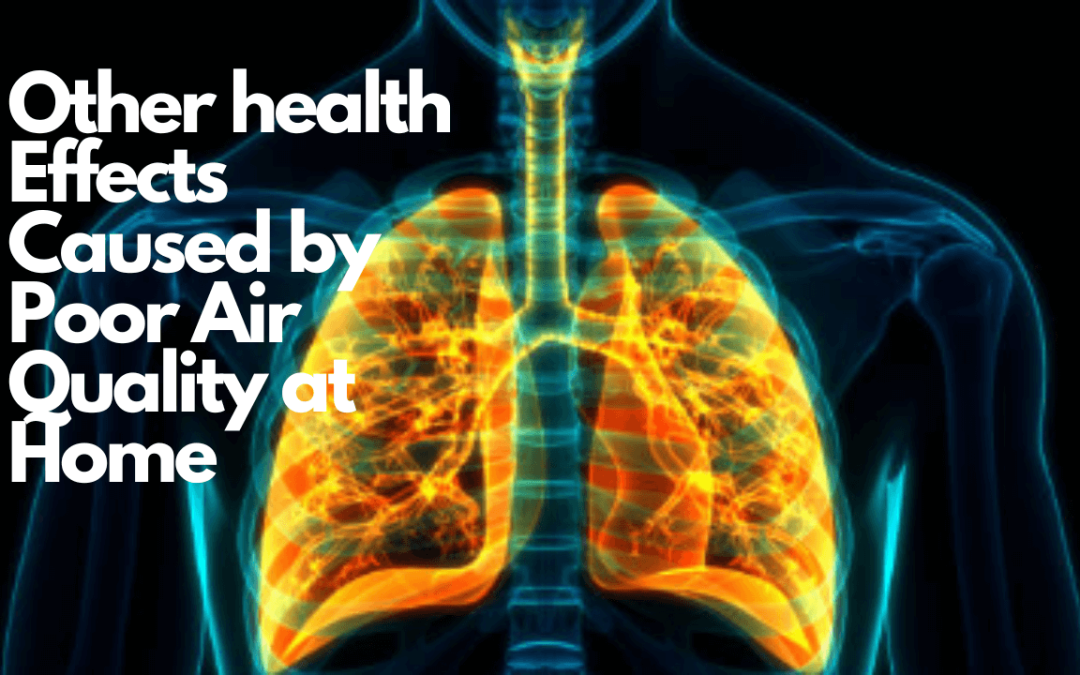Poor air quality is a global issue with significant impacts on human health and the environment, encompassing various pollutants from both outdoor and indoor sources. Understanding its health effects is crucial, especially since we spend much time indoors, where air quality can significantly impact our well-being. This article explores how poor indoor air quality can affect respiratory and cardiovascular health, cognitive function, and mental well-being, and introduces “Other health Effects Caused by Poor Air Quality at Home” as a vital aspect of overall health. By the end, you’ll appreciate the importance of taking proactive steps to improve the air quality in your home, aligning with our commitment to promoting a healthier living environment and sustainable choices.
Respiratory Health Effects
Poor indoor air quality poses a significant threat to respiratory health. It can trigger and exacerbate various respiratory problems, including:
- Asthma: Poor indoor air quality acts as a trigger for asthma attacks, leading to symptoms like coughing, wheezing, shortness of breath, and chest tightness.
- Allergies: Indoor air pollutants like dust mites, mold, and pet dander can provoke allergic reactions, resulting in symptoms like sneezing, a runny nose, and itchy eyes.
- Chronic obstructive pulmonary disease (COPD): Poor indoor air quality can worsen COPD symptoms, including persistent coughing, shortness of breath, and chest tightness.
Research shows that indoor air pollution contributes to respiratory diseases, with the World Health Organization reporting millions of annual deaths. To mitigate these risks, it’s essential to improve indoor air quality by using air purifiers, enhancing ventilation, reducing indoor pollutants, and avoiding indoor smoking. Concerned about both people and the environment, we promote healthy indoor environments and sustainable practices.
Cardiovascular Health Effects
Poor indoor air quality not only affects human health but also poses significant risks to the cardiovascular system. Indoor air pollutants can enter the bloodstream and lead to various cardiovascular problems:
- Heart disease: Indoor air pollutants like nitrogen dioxide and particulate matter increase the risk of heart disease and worsen existing heart conditions, potentially causing chest pain, heart attacks, and complications.
- Stroke: Poor indoor air quality is linked to an elevated risk of stroke as pollutants can trigger inflammation and oxidative stress, damaging blood vessels in the brain.
- High blood pressure: Exposure to indoor air pollutants, especially particulate matter, is associated with higher blood pressure, contributing to heart disease, stroke, and other health issues.
Studies highlight the significant impact of poor indoor air quality on cardiovascular health. The American Heart Association notes that air pollution can be as harmful to the heart as smoking. To mitigate these risks, it’s essential to enhance indoor air quality with measures like air purifiers, improved ventilation, reduced indoor pollutants, and avoiding indoor smoking. As arborists concerned about people and the environment, we advocate for healthy indoor spaces and sustainable practices that promote better air quality.
Cognitive and Mental Health Effects

Poor indoor air quality doesn’t just affect physical health but also has significant implications for cognitive and mental well-being, a major concern for arborists like us. Indoor air pollutants can impact the brain, leading to various cognitive and mental health issues:
- Poor concentration and memory: Exposure to indoor air pollutants, especially volatile organic compounds (VOCs), has been linked to difficulties in concentration and memory, potentially affecting cognitive development in children.
- Depression and anxiety: Indoor air quality is associated with a higher risk of depression and anxiety. Inflammatory responses triggered by indoor air pollutants can alter mood and behavior.
- Sleep disturbances: Poor indoor air quality can disrupt sleep, causing insomnia and sleep apnea. Irritating pollutants can lead to nasal congestion and breathing problems, hindering restful sleep.
Scientific research supports the connection between poor indoor air quality and cognitive and mental health problems. The World Health Organization acknowledges that indoor air pollutants are linked to various cognitive and mental health conditions, including dementia and Alzheimer’s disease.
To mitigate these risks, it’s crucial to improve indoor air quality by using air purifiers, enhancing ventilation, reducing indoor pollutants like certain cleaning products, and avoiding indoor smoking. As arborists, we prioritize overall well-being and advocate for sustainable practices that create healthy indoor environments and enhance air quality.
Other Health Effects

“Examples of substances found at some workplaces that increase risk include asbestos, arsenic, diesel exhaust, and some forms of silica and chromium. For many of these substances, the risk of getting lung cancer is even higher for those who smoke. Living in areas with higher levels of air pollution may increase the risk of getting lung cancer.” What Are the Risk Factors for Lung Cancer? Division of Cancer Prevention and Control, Centers for Disease Control and Prevention
Poor indoor air quality has numerous other health consequences, which are of great concern for arborists like us. Here are some common health issues associated with poor air quality at home:
- Eye irritation: Indoor pollutants like ozone and particulate matter can cause burning, redness, and itching of the eyes.
- Headaches: Exposure to indoor pollutants, such as VOCs and formaldehyde, can trigger headaches, especially in sensitive individuals.
- Skin irritation: Indoor air pollutants like formaldehyde can lead to skin irritation, including itching and rashes.
- Cancer: Some indoor pollutants like radon and asbestos have been linked to an increased risk of cancer.
- Pregnancy complications: Poor indoor air quality can impact pregnancy outcomes, potentially causing low birth weight and preterm delivery.
Extensive research has shown that poor indoor air quality can result in a wide range of health issues, including Other Health Effects Caused by Poor Air Quality at Home. To improve indoor air quality, it’s essential to avoid products that emit indoor pollutants, enhance ventilation, and use air purifiers. By prioritizing these measures, we can reduce the risk of health problems and promote overall well-being. As arborists, we stress the importance of creating healthy indoor environments that support better air quality and the well-being of individuals and their families.
Conclusion
Poor air quality at home is a significant concern for us, as it affects our health and overall well-being. It impacts respiratory, cardiovascular, cognitive, and mental health and can even lead to serious conditions like asthma, heart disease, depression, and cancer. Other health Effects Caused by Poor Air Quality at Home include eye irritation, headaches, and skin conditions, further emphasizing the need for improved air quality.
The good news is that there are many ways to improve indoor air quality and reduce health risks. Using air purifiers, improving ventilation, minimizing indoor pollutants, and not smoking indoors can all help.
Additionally, we must recognize that outdoor air pollution can also affect indoor air quality. Therefore, we should support policies that reduce emissions from vehicles and industries to address the root causes of outdoor air pollution.
In summary, addressing poor indoor air quality is essential for public health. By taking individual and collective actions to improve indoor air quality and tackle outdoor air pollution, we can protect our health and create a healthier and more sustainable future. As arborists, we are committed to creating environments that promote optimal health and harmonious coexistence between nature and humanity.

